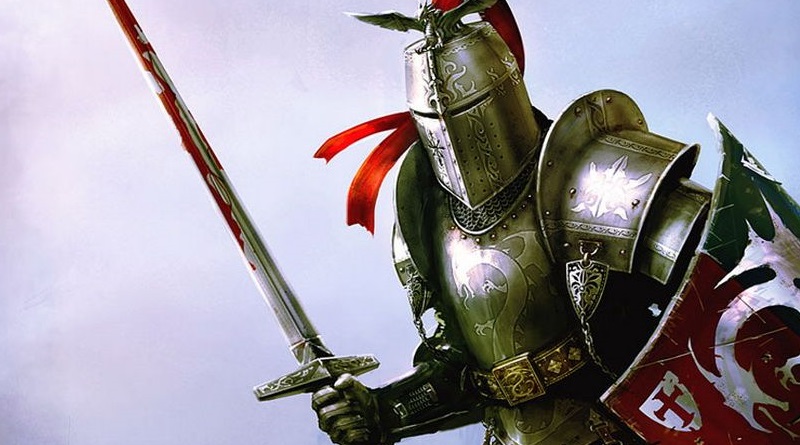Battlefield Fashions
Revised and expanded armour for D&D
To support the “higher equals better” AC system, we’ve expanded the roster of available armour to include a few new suits and several accessories. The AC values of the items cited below are cumulative, and, as expected, the higher one’s armour class, the better defended he is.
A nice by-product of this system is that it allows combatants to “accessorise” their protective devices. Instead of merely wearing “chain mail,” a character could don a chain mail shirt, plate greaves, and a plate helm. The additional protections are reflected in the character’s improved AC (and increased encumbrance), and, to prevent players from “layering” armour types and abusing the system, no more than one protective device may cover a single body location (noted as (H)ead, (T)orso, (A)rm, and (L)eg).
Following the Armour Table are descriptions of the armour types and a short instructional guide for creating new protective devices consistent with those cited herein.
Armour Table
The following replaces the Armour Table found on RC/67; note especially the changes in cost and weight for most standard items:
| Armour Type | AC Mod | Cost (gp) | Enc (cn) | Body Location(s) |
| Banded Mail | +5 | 60 | 450 | Torso, Arms |
| Chain Mail | +4 | 40 | 400 | Torso, Arms |
| Full Plate Armour | +10 | 140 | 800 | Head, Torso, Arms, Legs |
| Half Plate Armour | +8 | 110 | 650 | Head, Torso, Arms, Legs |
| Lamellar Armour | +5 | 70 | 400 | Torso, Arms |
| Leather Armour | +1 | 10 | 100 | Torso, Arms |
| Plate Mail | +6 | 80 | 500 | Torso, Arms, Legs |
| Scale Mail | +3 | 30 | 300 | Torso, Arms |
| Studded Leather Armour | +2 | 20 | 200 | Torso, Arms |
| Shields | AC Mod | Cost (gp) | Enc (cn) | Body Location(s) |
| Shield, Large | +3 | 30 | 375 | N/A |
| Shield, Medium | +2 | 20 | 250 | N/A |
| Shield, Small | +1 | 10 | 125 | N/A |
| Shield, Tower | +4 | 40 | 500 | N/A |
| Accessories | AC Mod | Cost (gp) | Enc (cn) | Body Location(s) |
| Chain Hood | +1 | 20 | 100 | Head |
| Chain Leggings/Skirt | +2 | 20 | 200 | Legs |
| Fur Cap (heavy) | +1 | 10 | 150 | Head |
| Fur Wrappings | +1 | 5 | 175 | Torso |
| Fur Leggings | +1 | 10 | 100 | Legs |
| Leather Bracers | +1 | 15 | 50 | Arms |
| Leather Breastplate | +1 | 10 | 150 | Torso |
| Leather Greaves | +1 | 20 | 50 | Legs |
| Leather Leggings | +1 | 10 | 100 | Legs |
| Plate Bracers | +2 | 30 | 100 | Arms |
| Plate Breastplate | +3 | 40 | 400 | Torso |
| Plate Greaves | +2 | 40 | 100 | Legs |
| Plate Helm (full) | +2 | 50 | 150 | Head |
| Plate Helm (half) | +1 | 10 | 150 | Head |
Armour Descriptions
The following descriptions replace those found in RC/67-8:
Banded Mail: A suit of heavy leather to which is affixed metal strips or studs. A suit of banded mail covers the Torso and Arms.
Chain Mail: A shirt of interlocking metal rings, typically worn over a padded shirt (to prevent weapon blows from driving ripped metal rings into flesh). A suit of chain mail covers the Torso and Arms, though it is often accessorised with a chain hood and leggings (see below).
Full Plate: Consists of stout steel plate over a thick chain mail suit that covers all body locations. Full plate must be custom fitted for a specific individual’s body measurements, necessitating the services of a tailor (this is not included in the cost above). In addition to a high AC modifier, those wearing full plate gain a +2 bonus against all saves against non-gaseous, area-of-effect attacks (e.g., the bonus applies to a red dragon’s breath or an insect swarm spell, but not a green dragon’s breath or a cloudkill spell). Full plate does impose some limitations, however: while wearing full plate, the wearer suffers a -4 penalty to all DEX-based ability checks and general skills, or any skills dealing with vision, hearing, or mobility.
Half Plate: Half plate consists of steel plates over light chain mail that covers all body locations. Like full plate, half plate must be tailored for a a specific individual (this is not included in the cost above). Half plate provides a +1 bonus against any non-gaseous, area-of-effect attack (see Full Plate for examples). However, certain movement and perception is limited; those wearing half plate suffer a -2 penalty to all DEX-based ability checks and general skills, or any skills dealing with vision, hearing, or mobility.
Lamellar Armour: Common among the nomadic horse warriors of the steppe, lamellar is fashioned from thin strips of metal fastened together with leather thongs. It is not normally available for purchase, though it is highly favoured for its superb, lightweight protective qualities. Lamellar covers the Torso and Arms.
Leather Armour: A suit of thin leather armour, often toughened and shaped by boiling hides in wax. Favoured by thief-types, leather armour is very common and covers the Torso and Arms.
Plate Mail: A suit of light chain to which is affixed a metal breastplate, bracers, and greaves. Like chain mail, it is worn over a padded shirt and its construction typically ensures that it is well-balanced over the wearer’s frame. Plate mail covers the Torso, Arms, and Legs; a full- or half-helm (see below) often accompanies such armour.
Scale Mail: A light suit of leather to which is riveted an array of light metal strips or scales. While conceptually similar to lamellar armour (q.v.), scale mail’s reliance on rivets make the wearer far less mobile for the relative protection offered. Scale mail covers the Torso and Arms.
Studded Leather Armour: A suit of boiled leather to which is attached a series of well-spaced metal studs. Studded leather is also used by thief-types, though it is significantly more restrictive than a suit of normal leather (q.v.). Studded leather armour covers the Torso and Arms.
Shields
Shield, Large: Also called a kite shield, a large shield is firmly attached to a combatant via several arm straps; it is effective against up to three attacks per combat round.
Shield, Medium: A medium, or round, shield is held by a combatant via a pair of forearm and upper arm straps; it is useful against two attacks per combat round.
Shield, Small: Also called a target shield or buckler, a small shield is held by a combatant by a single hand-strap; it is effective against one attack per combat round.
Shield, Tower: A tower, or wall, shield can be as large as its wielder. It is not meant for melee combat, but instead is firmly planted into the ground to protect a non-mobile combatant (typically an archer or crossbowman who needs cover whilst reloading). So long as the wielder is stationary, a tower shield is effective against all attacks during a given combat round; if the attacker moves (e.g., to attack), the shield protects against up to four attacks in a single round.
Accessories
Chain Hood: A light hood of interlocking metal rings that covers the Head.
Chain Leggings/Skirt: Chain mail leg protection consisting of interlocking metal rings fashioned into pants or a skirt. Both offer the same protection to the Legs, though chain leggings are more suited to mounted troops while chain skirts are fitted for infantry.
Fur Cap (heavy): A heavy bundle of thick pelts that cover the Head.
Fur Wrappings: A swaddling bunch of thick pelts twined with leather to protect the Torso.
Fur Leggings: Heavy fur pelts stitched together in a form of trousers that protect the Legs.
Leather Bracers: A pair of light leather patches designed to protect the upper and lower Arms. Bracers impose a -1 IR penalty to any HH or HR weapon attack.
Leather Breastplate: A breastplate of light, boiled leather that covers the Torso.
Leather Greaves: A pair of light leather patches designed to protect the upper and lower Legs. Greaves of this sort impose a -1 IR penalty to any 2H weapon attack.
Leather Leggings: Similar in protective value to a pair of leather greaves (q.v.), leather leggings are essentially leather trousers.
Plate Bracers: A pair of thick metal plates protecting the upper and lower Arms. Plate bracers impose a -2 IR penalty to any HH or HR weapon attack.
Plate Breastplate: A steel breastplate covering the Torso; such does not typically cover the wearer’s back.
Plate Greaves: A pair of thck metal plates protecting the upper and lower Legs. Plate greaves impose a -2 IR penalty to any 2H weapon attack.
Plate Helm (full): A steel helm covering the entire Head. While highly protective, a full-helm limits the wearer’s perception, imposing a -2 penalty to all surprise checks.
Plate Helm (half): A steel helm covering the top (and maybe back and sides) of the Head. A half-helm limits somewhat the wearer’s perception, and all surprise checks are penalised by -1.
Creating New Protective Devices
To introduce new armour types, shields, or accessories into your campaign, a set of simple formulae can help ensure consistency. For those short on time, you can download the Armour Generator, a quick-and-dirty Windows programme based on the instructions below. The first step in designing a protective device is determining the desired AC modifier. From there, these base values follow:
| Protective Device | Base Cost (gp/+1 AC) | Base Enc. (cn/+1 AC) |
| Armour (suit) | 10 | 100 |
| Shield | 10 | 125 |
| Accessory | See below | See below |
Encumbrance variations indicate differences in wearability. Suits of armour are composed of multiple pieces designed to fit together, so in concert, they perform well. Shields must be carried and can be bulky or unwieldy outside of combat. Accessories, while useful, are by definition disparate, so they rarely fit together as a well-balanced whole. As we shall see, a single suit of plate mail covering the Torso, Arms, and Legs is better balanced than a breastplate, bracers, and greaves made as separate pieces of plate.
To reflect differences in construction materials, workmanship, or other innovations, do not adjust the AC modifier (because that’s the value you started with). Instead, adjust the item’s encumbrance and shift the cost by an additional 5gp for every 25cn reduction in weight (i.e., cost increases as weight decreases). Alternately, weight increases reduce cost by the same amount (i.e., subtract 5gp for each additional 25cn encumbrance).For example, plate mail grants a +6 AC; it follows that it costs 60gp and weighs 600cn. However, plate mail is well-balanced: we reflect this by exchanging 100cn of weight for a price tag of an additional 20gp. If a suit of plate mail were made of some heavier grade of steel, we could increase its weight to 650cn, for example, and charge 50gp.
Creating new armour accessories (or piecemeal armour) follows the process above, though any accessory can cover only one body location (unlike the standard armour types above). As before, begin designing the accessory with a desired AC modifier and follow through with the cost and encumbrance values cited below:
| Accessory Covers | Base Cost (gp/+1 AC) | Base Enc. (cn/+1 AC) |
| Head | 20 | 100 |
| Torso | 10 | 150 |
| Arms | 5 | 100 |
| Legs | 10 | 100 |
Any modifications to the accessory should be indicated as encumbrance adjustments, followed by price changes using the inverse cost-to-weight ratio as above (i.e., 5gp:25cn).
For example, the DM creates a stout leather cap that affords a +1 AC bonus and covers the Head. Using the AC modifier as a base on the table above, the accessory costs 20gp and weighs 100cn. For the same price, a suit of leather armour (AC +2) is available, though at a weight of 200cn. In essence, the cap (without further modification) offers half the protection of full leather, at equal the cost but one-half the weight.
This example helps illustrate the inefficiency of trying to “dovetail” separate accessories when a whole armour suit might be more practical. To see this acutely, review a comparison between a suit of plate mail and its component accessories:
| Type | AC Mod | Cost | Enc |
| Plate Mail | +6 | 80 | 500 |
|
|
|||
| Plate Bracers | +2 | 30 | 100 |
| Plate Breastplate | +3 | 40 | 400 |
| Plate Greaves | +2 | 40 | 100 |
| Totals | +7 | 110 | 600 |
Clearly, the players must evaluate carefully the worth of such tradeoffs.



